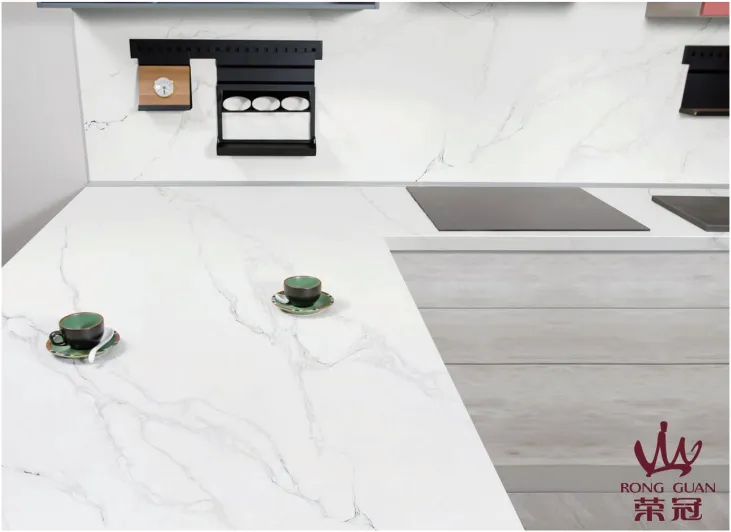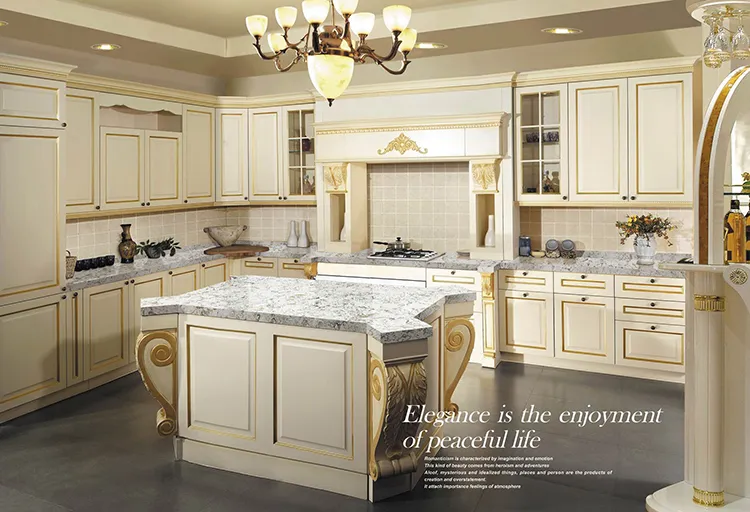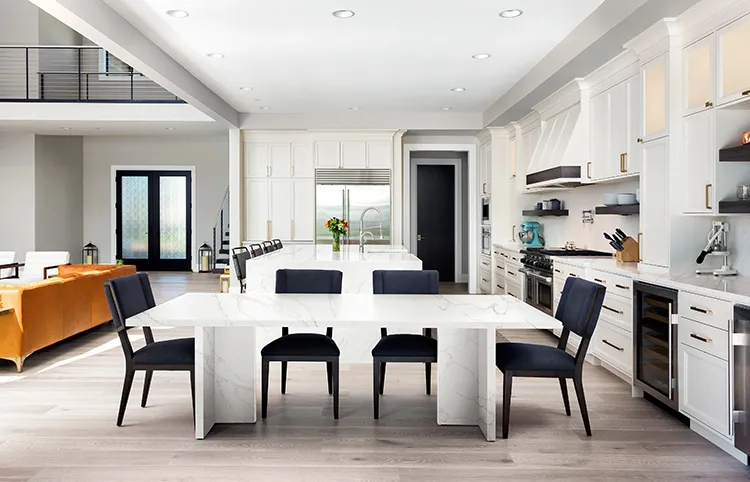The kitchen is not only a place to cook delicious food, but also an important space in home decoration to show personal style and taste. A successful kitchen design not only relies on functionality, but also needs to take into account aesthetics. For many people who want to remodel their kitchen with a new quartz stone countertop in 2025, how to match the backsplash with the quartz stone countertop is a question.
Quartz stone countertops are one of the most beautiful stones and are often used in traditional and modern kitchens. In this design, the matching of quartz stone countertops and backsplashes plays a key role. So, how to create a kitchen space that is both practical and stylish in 2025? Today, we will explore how to perfectly match the backsplash with the quartz stone countertop to provide inspiration and practical suggestions for your kitchen design.

How to choose the best backsplash for quartz stone countertops?
When choosing the best backsplash for quartz stone countertops, the first thing to consider is the coordination and functionality of the overall design. Quartz stone countertops have become a popular choice in modern kitchens because of their durability, easy cleaning, and diverse color and texture options. However, an excellent countertop design must be perfectly combined with the backsplash to make the entire kitchen space both beautiful and practical.
First, you need to clarify the overall style and tone of the kitchen. If your kitchen design tends to be modern, then a simple backsplash, such as glass or metal, may be a good choice. If you prefer traditional or country style, classic tile or natural stone backsplashes are more harmonious with quartz stone countertops. Secondly, consider the color matching of the countertop and backsplash. The coordination and contrast of colors are the key factors that determine the overall visual effect. You can choose a color similar to the quartz stone countertop to create a sense of unity, or choose a contrasting color to highlight the layering and visual focus of the kitchen.
Finally, functionality is also an important consideration when choosing a backsplash. The backsplash must not only be beautiful, but also have characteristics such as durability, easy cleaning and waterproofness to cope with various usage needs in the kitchen.

How to choose a backsplash?
When choosing a backsplash, you need to consider the material aspect. The material of the backsplash directly affects its appearance, durability and cleaning difficulty. Common backsplash materials include tile, glass, metal, natural stone, and synthetic materials. Different materials have different advantages and disadvantages:
● Tile: Tile is one of the most common backsplash materials. It is durable and easy to clean. Tile has a wide range of patterns and colors to choose from, suitable for kitchens of all styles. However, the joints of tiles are prone to dirt accumulation and need regular cleaning and maintenance.
● Glass: Glass backsplashes are sleek and modern, easy to clean, and have a good reflective effect, which can make the kitchen look brighter. Glass backsplashes can also be customized with printed patterns or colors, but they are more expensive to install and glass materials may be prone to scratches.
● Metal: Metal backsplashes, such as stainless steel or aluminum, are extremely durable and modern, perfect for industrial or modern style kitchens. However, metal surfaces are prone to fingerprints and water stains and need to be cleaned frequently.
● Natural stone: Natural stone, such as marble and granite, has a unique texture and high-end appearance, which is particularly harmonious with quartz stone countertops. However, natural stone is usually more expensive, and some materials need to be sealed regularly to prevent water seepage and stains.
● Synthetic materials: Synthetic materials, such as acrylic and resin composite panels, are generally durable and water-resistant, while offering a variety of color and texture options. These materials are more affordable and easy to clean.
When choosing a backsplash, you can also consider color and pattern. The choice of color and pattern is crucial to the matching of the backsplash with the quartz stone countertop. You can choose a backsplash with a similar color to the quartz stone countertop to create a sense of unity, or choose a contrasting color to increase visual impact. In terms of pattern selection, if the countertop is solid color or simple texture, you can consider using a backsplash with a complex pattern, such as mosaic tiles or geometric designs, to increase the dynamics of the space. If the countertop itself is rich in texture, the backsplash should choose a simpler design to avoid visual conflict.
Secondly, you can also consider the size and shape. The size and shape of the backsplash needs to be determined according to the specific situation of the kitchen space. Generally, the height of the backsplash should cover the bottom of the cabinet to protect the wall from smoke and water stains. For an open kitchen or modern kitchen, you can choose a larger backsplash, or even extend it to the ceiling to create a visual extension.
Finally, when choosing a backsplash, you also need to consider its functional needs. For example, certain areas of the kitchen, such as behind the stove or sink, may require a material that is particularly heat-resistant or waterproof. In addition, if your kitchen often handles ingredients with strong odors, it would be more appropriate to choose a backsplash material that is easy to clean and antibacterial.

What is the best material for a kitchen backsplash?
No one material is perfect for all kitchen needs, but different materials have their best application scenarios. Ceramic tiles are suitable for kitchens with a lower budget and a variety of designs. Ceramic tiles are easy to install and replace, durable and easy to clean, but special attention needs to be paid to the seams. Glass is suitable for modern, minimalist kitchens, especially smaller spaces that need reflective effects. Glass is easy to clean, but the installation cost is higher.
Metal is perfect for industrial or modern kitchens. It is durable and easy to clean, but it is easy to show fingerprints and water stains. Natural stone is suitable for high-end, classic-style kitchens, with unique beauty and texture, but requires regular maintenance. Synthetic materials are suitable for a variety of kitchen styles, with great durability and a variety of design options, and are moderately priced. The final choice should be determined by your kitchen style, functional needs, and budget.
How much does it cost to install a kitchen backsplash?
Tile backsplashes usually cost between $10 and $50 per square foot, depending on the type and quality of the tile. Glass backsplashes are more expensive, generally between $30 and $100 per square foot. Metal backsplashes cost between $25 and $75 per square foot, while natural stone backsplashes can cost as much as $50 to $200 per square foot. Synthetic backsplashes are more moderately priced, generally between $20 and $60 per square foot.
Installation costs vary depending on the material. Tile backsplashes usually cost between $10 and $30 per square foot to install, while glass backsplashes cost more, possibly between $20 and $50 per square foot. Metal and natural stone backsplashes are generally more expensive to install, and the installation process is more complicated and requires professional technicians to install.
Therefore, the total cost of installing a backsplash for a standard kitchen is usually between a few hundred dollars and a few thousand dollars, depending on the material selected and the complexity of the installation.
What kind of backsplash is easy to clean?
Cleaning difficulty is an important consideration when choosing a backsplash, especially in a high-frequency space such as the kitchen. Glass backsplashes have a smooth and non-porous surface and are easy to clean. Simply wipe gently with a damp cloth to remove oil and water stains. For stubborn stains, you can use glass cleaner. The only cleaning challenge of glass backsplashes is that they easily leave fingerprints and water stains.
Tiles themselves are easy to clean, but the joints between tiles are prone to accumulate dirt and oil stains, and need to be cleaned and maintained regularly with specialized cleaners. To reduce the difficulty of cleaning, choose larger tiles or seamless tiles with fewer joints. Metal backsplashes (such as stainless steel) have a smooth surface and are easy to clean, but they are prone to fingerprints and water stains. Regularly wipe with a special stainless steel cleaner to keep the surface shiny and new.
Synthetic backsplashes are usually very stain-resistant and water-resistant and easy to clean. Use a neutral detergent and a damp cloth to keep the surface clean. Natural stone surfaces such as marble and granite are easily penetrated by stains, especially when they are not sealed. Although natural stone is extremely beautiful, it is expensive to clean and maintain, and requires regular sealing to prevent stains from penetrating.
How to match the backsplash with the quartz stone countertop?
Matching the backsplash with the quartz stone countertop is not only about the choice of color and material, but also about the coordination of the overall design. Choosing a backsplash that is similar in color to the quartz stone countertop can create a harmonious and unified visual effect. This combination is suitable for users who like a simple style and can make the kitchen space look more neat and integrated. If you want to highlight the visual focus in the kitchen, you can choose a backsplash that is a contrasting color with the quartz stone countertop. For example, a white quartz stone countertop can be paired with a dark or light backsplash to create a sharp contrast effect. This combination is suitable for users who pursue personalized design and can make the kitchen more fashionable and dynamic.
Quartz stone countertops usually have delicate textures. If you want to continue this texture on the backsplash, you can choose materials with similar textures to the countertops, such as natural stone or imitation stone tiles. This can create a natural transition visually and enhance the coordination of the overall design. If the quartz stone countertop is solid color or simple texture, you can choose a backsplash with patterns, such as mosaic tiles or geometric designs, to increase the dynamics of the space. If the countertop itself has rich textures, the backsplash should choose a simpler design to avoid visual conflict.
Should the backsplash be lighter or darker than the quartz stone countertop?
The color choice of the backsplash, whether it should be lighter or darker than the quartz stone countertop, depends on the overall kitchen design style and personal preference. If your kitchen space is small or not well lit, a light-colored backsplash can enhance the sense of space and make the kitchen look brighter and more spacious. A light-colored backsplash paired with a dark quartz stone countertop can create a strong visual contrast and highlight the presence of the countertop. Dark backsplashes paired with light-colored quartz stone countertops can create a calm and noble atmosphere. Dark backsplashes are easier to hide oil and water stains, suitable for families who cook frequently. Secondly, choosing a backsplash with a color similar to the quartz stone countertop can create a sense of unity, which is suitable for users who pursue a simple style. This combination will not make the kitchen look too abrupt, but more unified and coordinated.

What is the rule of thumb for backsplashes?
The design of the backsplash should be coordinated with the countertops and cabinets, avoiding overly complex patterns or colors to avoid visual confusion. Choose a backsplash material that is easy to clean, durable, and meets the needs of kitchen use to ensure that it can withstand the test of daily cooking. In addition, choose the right material and design according to your budget, considering both aesthetics and actual use and maintenance costs. Finally, the backsplash should match the design style of the entire kitchen, taking into account the colors and materials of the countertops, cabinets, floors, and walls to make the entire space look harmonious and unified.
Hopefully, this guide will provide you with valuable references for your kitchen renovation, helping you find the best backsplash and quartz stone countertop combination for your home among the many options. No matter which style of backsplash you ultimately choose, remember that the kitchen is not only a place for cooking, but also the heart of life and family. Let your kitchen design reflect your personality and taste, and bring more joy to you and your family.

